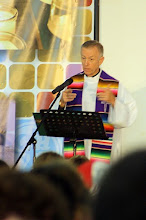

How easy it is to rattle off, in The Divine Praises, “Blessed be Jesus Christ, true God and true man,” and never realize the struggle the early Church found itself in, trying to sort out how this could be true! How is Jesus of Nazareth also somehow divine? How is the eternal Son of God somehow an incarnate human? Beyond that, there was a common philosophical belief (also shared, to a great degree, by Christians) which said “God and matter do not mix.” What a problem for theology and for faith this was.
Leo’s famous Tomus ad Flavianum (a theological letter addressed to the Patriarch of Constantinople) was adopted by the Council of Chalcedon in 451 as the definition of how this incarnation of the God-man should be understood. It wasn’t the last word in the controversy, but it has held the line ever since as what we call “orthodoxy.” The contents of Leo’s letter are summarized by the devotional line in the first paragraph.
Leo was a politician as well as a theologian. The bas-relief images along with this blog post are from St Peter’s in Rome, created by the Baroque artist Alessandro Algardi. They show Leo in 452, confronting none other than Attila the Hun, persuading him not to sack the City. The detail shows Leo gesturing to the heavens, past the processional cross behind him, but Attila sees instead Ss Peter and Paul ready to do battle against his forces—he thinks better of his plan and (with money, it must be added) retreats.
I observed in the daily homily today that one can go to St Peter’s in Rome and see not only Algardi’s bas-relief but also the tomb of Pope Leo himself. It is the mark of a tremendous continuity of history and faith—Leo, the formulator of Catholic doctrine, the diplomat of the imperial City, the successor of Peter. Remember him the next time The Divine Praises end Eucharistic adoration and benediction.
Leo’s famous Tomus ad Flavianum (a theological letter addressed to the Patriarch of Constantinople) was adopted by the Council of Chalcedon in 451 as the definition of how this incarnation of the God-man should be understood. It wasn’t the last word in the controversy, but it has held the line ever since as what we call “orthodoxy.” The contents of Leo’s letter are summarized by the devotional line in the first paragraph.
Leo was a politician as well as a theologian. The bas-relief images along with this blog post are from St Peter’s in Rome, created by the Baroque artist Alessandro Algardi. They show Leo in 452, confronting none other than Attila the Hun, persuading him not to sack the City. The detail shows Leo gesturing to the heavens, past the processional cross behind him, but Attila sees instead Ss Peter and Paul ready to do battle against his forces—he thinks better of his plan and (with money, it must be added) retreats.
I observed in the daily homily today that one can go to St Peter’s in Rome and see not only Algardi’s bas-relief but also the tomb of Pope Leo himself. It is the mark of a tremendous continuity of history and faith—Leo, the formulator of Catholic doctrine, the diplomat of the imperial City, the successor of Peter. Remember him the next time The Divine Praises end Eucharistic adoration and benediction.

No comments:
Post a Comment